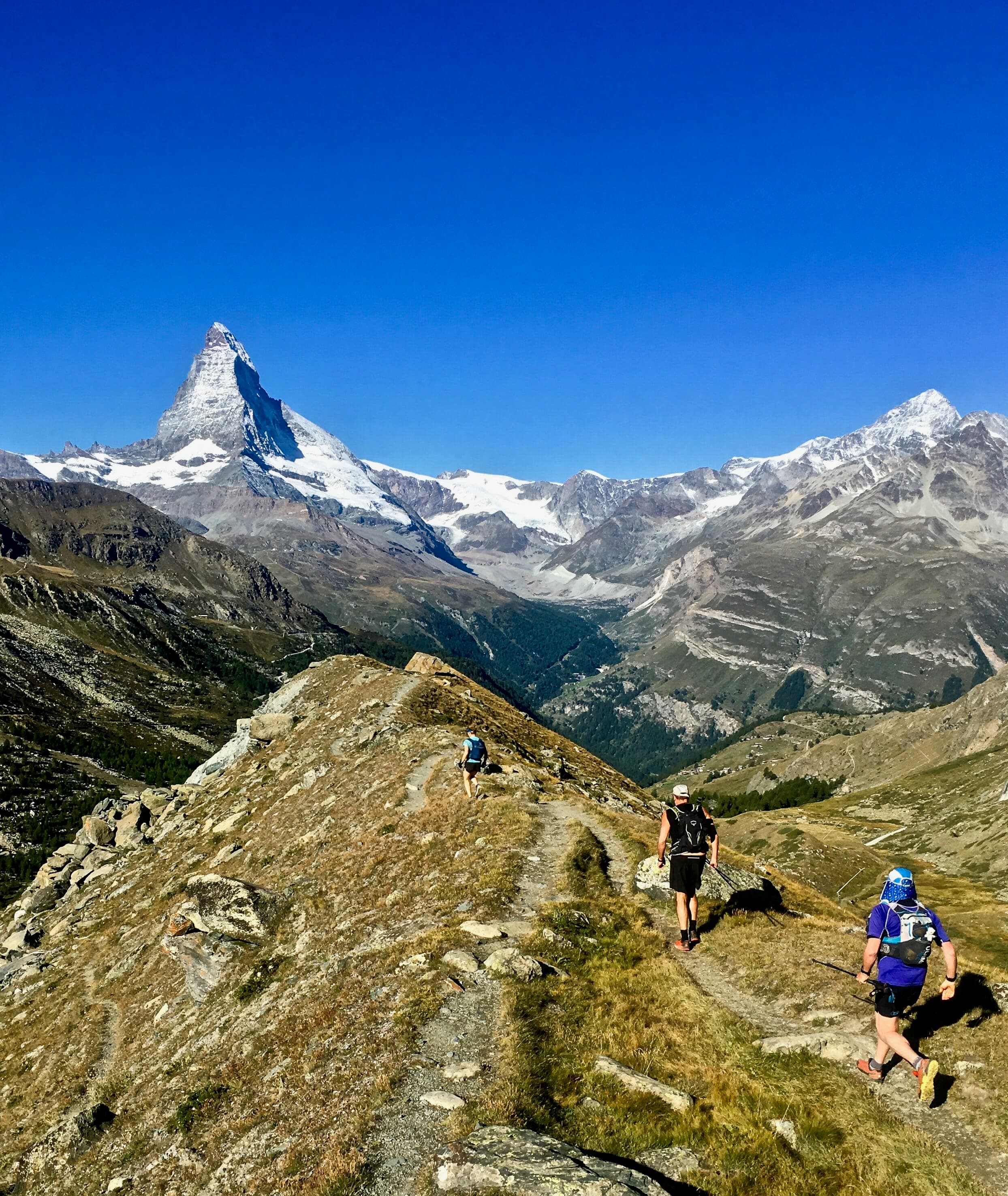

Run the Alps’ Inaugural Via Valais: Snow and Sun amid the High Alps

Our story starts in the deepest recess of Switzerland’s Valais canton, in the Val d’Hérens at the Grand Hotel Kurhaus, which sits among the pines, a little higher than the cluster of buildings that constitute Arolla.
Autumn has arrived. The mountains are shrouded in cloud. Cold rain falls at intervals, enough to darken the forest by a couple of shades. In clearer moments the mighty Mount Collon rises at the head of the valley. A small glacier clings determinedly to its steep north face, on top of which, another glacier caps the mountain. Rock, ice, cloud and rain. I turn my gaze elsewhere, to the orange flames dancing in the hearth, above which hang portraits of significant people, long departed. I ponder resigning my commission as guide and checking myself in here for as long as it takes to write a book.
This inaugural Run the Alps Via Valais tour, designed by our friends at Alpsinsight, follows a line similar to the famed Haute Route ski tour, though deliberately lower and more runnable. The trajectory is west to east, which means largely parallel to the great glacial spine of the alps, as it runs from Mt Blanc through to the Matterhorn, Monte Rosa and beyond. From these high, glacial landscapes pour forth great rivers, running perpendicular to our route, carving out great valleys and leading ultimately to the greatest valley of all in the region, the Rhône.
In keeping with tried and tested formulae, the first day is a “shake out” run, a chance to find our feet, tweak and adjust our gear, and generally bed-in. We take a tour up to the Cabane des Aiguilles Rouges (Cabin of the Red Needles), passing the beautiful Lac Bleu and ascending 800m or so, into the clag (Editor’s note: “Clag” is thick, unpleasant cloud in Mark’s British dialect). At the cabin we are the only guests. A sausage-fingered guardian ladles piping hot ‘hut soup’ into bowls and cuts not-quite-as-big-as-we’d-like pieces of delicious orange cake. We enjoy the shelter, the hot food and a fast-evolving sense of camaraderie.
The following morning the world’s grumpiest bus driver transports us, grudgingly, down to the village of Les Haudères, from whence we start our six-day transit to Zermatt with a gentle run next to the river Borgne, through woods and meadows, as far as Evolène, where we stop for coffee.
The day’s climb takes an upward traversing line through forests of pine, richly adorned with bright green lichen and alive with the call-and-answer screeching of jays and the chatter of alpine squirrels. From this timeless foliage we emerge into high alpine pastures, take lunch at the cheese-making hamlet of La Vieille and continue upwards to Pas de Lona, a high pass above which we are swept by a chilling wind and flurries of hail; all of which serve only to hasten our progress to the Cabane des Becs de Bossons.
The welcome at the refuge is a warm one, both in terms of the smiles of our hosts and the glowing wood-burning stove. We enjoy hearty mountain fare, a convivial atmosphere, and early bed and wake to find a world transformed by snow.
Exploiting a break in the cloud we dart out after breakfast and enjoy descending back to Pas de Lona with soft snow beneath our feet. The landscape is now wintry, somehow Scottish, and beautiful beyond words.
- Taking the snow very seriously on Basset de Lona (Photo: Paul Ashton).
We cross the high, rolling plateau that separates the two valleys and are well progressed in our descent to Lac de Moiry when the weather window closes, wrapping us in cloud, pelting us with hail. It is cold, but at least it is frozen and thus dry. The unexpectedly turquoise waters of Moiry Lake merge with the cloud. The barrage takes shape, curved like a crescent waxing moon, the tip of which disappears into a vanishing point of grey cloud and turquoise water. Somewhere out there, on the other side, lies the warmth of a café. No further motivation needed.
Warmed, replenished and with another break in the weather beckoning, we climb to Col de Sorbois and descend to Zinal and the welcome comfort of Hotel Besso.
The day dawns clear and though we will hark back fondly to the wilder weather, we are nonetheless glad of the change, and the view. The crown of 4000m peaks that tower above Zinal are seen in full glory, freshly white and crisp against a clear blue sky.
Our progress from Zinal is on the pristine single track of the famed Sierre-Zinal mountain race, won only a few weeks previous and in record time by a certain Kilian Jornet. My appetite for this race has just increased – the trail is sublime!
We cross La Forcletta in glorious sunshine and enjoy the fine descent into Grüben, the quietest and most remote of the valleys that we cross. The Turtmann glacier, its jagged white serac teeth pointing skywards, spews its melt water into the head of the valley. Not so very far below, we sit for lunch in the garden of the Schwarzhorn Hotel and spectate.
The Augstbordpass is the final barrier that separates us from the Mattertal (tal being German for “valley”), at the head of which rises one of the world’s most spectacular mountains, the Matterhorn. It is not only the last, but the wildest of our crossings. As we emerge from the forest and crest a shoulder, a chill wind sweeps down from the pass. Into this headwind we set our course. The pass itself, deep in the recesses of this hanging side valley, is obscured by swirling cloud. Trusting that there is a passage becomes an act of faith.
Finally the headwall of the valley steepens. We clamber among boulders and zig-zag upwards until the gradient eases and we are at the col. On both flanks snowy ridges disappear into cloud. The wind is squeezed and accelerates through the col. It is no place for a picnic. We scamper down the other side, to gentler climes and an outstanding single track that clings, with a little help from Swiss engineering, to the steep flanks of the Mattertal and leads us to the perched settlement of Jungu. From here we descend to the comparatively warm, oxygen-rich air of St Niklaus.
Now that we have gained the Mattertal, our course turns southward and we enjoy a high traverse along the Europaweg. As we run a gentle curve so emerges the distinctive spike of the Matterhorn, appearing impossibly steep from this angle. We become better acquainted with this natural wonder from the terrace of the Fluehalp and indeed, from our bedroom windows that night as the rock spike stands moonlit under a starry sky.
- The changing face of the Matterhorn, seen from our hotel window at Fluealp (Photo: Mark Brightwell).
The final day yields one final climb, higher yet than any before. On tired legs and breathing oxygen-lean air, we battle the final meters to our trip high point of Gornergrat at 3100m.
“I can’t wait until this is over!” is soon overlaid by “Okay! It was worth it!” as a 360 panorama including Monte Rosa, Matterhorn, Weisshorn, Zinal Rothorn and Dent Blanche gives us one last defining impression of the mountains we have been lucky enough to spend the past week moving among.
So that was the inaugural Run the Alps Via Valais. The intrepid early adopters have pioneered, persevered and departed richer for it: souls alive, legs strong and minds etched with the memory of landscape and camaraderie that will keep them positively charged until their next adventure. The question now:
“Who will follow them?”

Looking towards Mont Collon from Arolla. (Photo: Mark Brightwell)

The team, ready to set off across the Valais Alps (Photo: Mark Brightwell).

Heading through cloud, sleet and hail up to Col de Sorebois (Photo: Mark Brightwell).

One of our first views of the Matterhorn, seen from the Europaweg trail, with Zermatt below (Photo: Mark Brightwell).

Beautiful single track – and plenty of sun! – on the way up to Gornergrat (Photo: Mark Brightwell)





